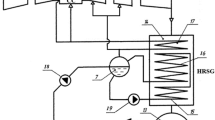Abstract
A high-temperature gas–steam turbine plant (GSTP) for ultrasupercritical steam conditions is proposed based on an analysis of prospects for the development of power engineering around the world and in Russia up to 2040. The performance indicators of a GSTP using steam from a coal-fired boiler with a temperature of 560–620°C with its superheating to 1000–1500°C by firing natural gas with oxygen in a mixingtype steam superheater are analyzed. The thermal process circuit and design of a GSTP for a capacity of 25 MW with the high- and intermediate-pressure high-temperature parts with the total efficiency equal to 51.7% and the natural gas utilization efficiency equal to 64–68% are developed. The principles of designing and the design arrangement of a 300 MW GSTP are developed. The effect of economic parameters (the level and ratio of prices for solid fuel and gas, and capital investments) on the net cost of electric energy is determined. The net cost of electric energy produced by the GSTP is lower than that produced by modern combined-cycle power plants in a wide variation range of these parameters. The components of a high-temperature GSTP the development of which determines the main features of such installations are pointed out: a chamber for combusting natural gas and oxygen in a mixture with steam, a vacuum device for condensing steam with a high content of nondensables, and a control system. The possibility of using domestically available gas turbine technologies for developing the GSTP’s intermediate-pressure high-temperature part is pointed out. In regard of its environmental characteristics, the GSTP is more advantageous as compared with modern condensing power plants: it allows a flow of concentrated carbon dioxide to be obtained at its outlet, which can be reclaimed; in addition, this plant requires half as much consumption of fresh water.
Similar content being viewed by others
References
A. A. Makarov, E. A. Volkova, F. V. Veselov, A. S. Makarova, L. V. Urvantseva, and N. V. Bobyleva, “Prospects of the development of electricity generation capacities in Russia,” Therm. Eng. 55 (2), 98 (2008).
V. S. Matyushin, L. N. Moiseeva, and Yu. K. Petrenya, “Development of Russia’s power engineering in the long term and new challenges faced by the industry of constructing power machinery and equipment,” Therm. Eng. 55 (1), 4 (2008).
Yu. A. Zeigarnik, V. M. Maslennikov, V. V. Nechaev, and I. S. Shevchenko, “Target view of the strategy of the Russian power engineering development during the period to 2030,” Therm. Eng. 54 (11), 851 (2007).
V. V. Bushuev and A. A. Troitskii, “Results from monitoring the energy strategy of Russia: problems of its implementation and the energy efficiency of the economy,” Therm. Eng. 52 (2), 85 (2005).
V. V. Bushuev and A. A. Troitskii, “Monitoring of the implementation of the 'Energy Strategy of Russia to the Year 2020' in 2004,” Therm. Eng. 52 (12), 903 (2005).
V. V. Bushuev and A. A. Troitskii, “The energy strategy of Russia until 2020 and real life. What is next?” Therm. Eng. 54 (1), 1 (2007).
V. V. Bushuev and A. A. Troitskii, “Monitoring of the progress achieved in 2007–2008 in implementing the energy strategy of Russia for the period up to 2020,” Therm. Eng. 56 (9), 715 (2009).
V. M. Batenin, Yu. A. Zeigarnik, and V. M. Maslennikov, “About the strategy for development of the Russian power engineering (after ten years),” Therm. Eng. 59 (4), 261 (2012).
A. G. Tereshin, A. V. Klimenko, and V. V. Klimenko, “Golden age of gas and its impact on the world energy, the global carbon cycle and climate,” Therm. Eng. 62 (5), 311 (2015), DOI: 10.1134/S0040363615050124.
A. A. Makarov, A Forecast for Development of Energy in Russia and Worldwide to 2040 (INEI RAN, Moscow, 2014) [in Russian].
“A gas–steam power installation with firing fuel in oxygen,” Therm. Eng. 57 (2), 175 (2010).
V. F. Kasilov and E. A. Zakharenkov, “Economic effectiveness of using super-high values of initial steam parameters in cogeneration power units,” Therm. Eng. 61 (9), 619 (2014), DOI: 10.1134/S0040363614090070.
G. G. Ol’khovskii, “Technologies for thermal power plants,” Gazoturb. Tekhnol., No. 10, 4–7 (1999).
Thermal and Nuclear Power Plants: A Handbook, Volume 3, Ed. by A. V. Klimenko and V. M. Zorina (MEI, Moscow, 2003) [in Russian].
S. K’yaer, “Experience gained from design and operation of power units for supercritical parameters,” Persp. Energetiki 6, 241–251 (2002).
G. S. Aslanyan and B. F. Reutov, “The outlook for the development of hydrogen power engineering remains highly conjectural,” Therm. Eng. 53 (4), 316 (2006).
V. M. Zaichenko, E. E. Shpil’rain, and V. Ya. Shterenberg, “Economic indicators characterizing an integrated technology for reprocessing natural gas and wood wastes to obtain hydrogen and pure carbon materials,” Therm. Eng. 53 (12), 998 (2006).
R. Z. Aminov, A. N. Bairamov, and O. V. Shatskova, “Assessment of the efficiency of hydrogen cycles on the basis of off-peak electric energy produced at a nuclear power station,” Therm. Eng. 56 (11), 940 (2009).
R. Z. Aminov and A. N. Egorov, “Evaluating the thermodynamic efficiency of hydrogen cycles at wet-steam nuclear power stations,” Therm. Eng. 60 (4), 255 (2013), DOI: 10.1134/S0040363613040012.
V. V. Klimenko, D. S. Beznosova, and A. G. Tereshin, “Does the Kyoto Protocol have a future?” Therm. Eng. 53 (5), 335 (2006).
Author information
Authors and Affiliations
Corresponding author
Additional information
Original Russian Text © A.V. Klimenko, O.O. Milman, B.A. Shifrin, 2015, published in Teploenergetika.
Rights and permissions
About this article
Cite this article
Klimenko, A.V., Milman, O.O. & Shifrin, B.A. A high-temperature gas-and-steam turbine plant operating on combined fuel. Therm. Eng. 62, 807–816 (2015). https://doi.org/10.1134/S0040601515110026
Published:
Issue Date:
DOI: https://doi.org/10.1134/S0040601515110026




